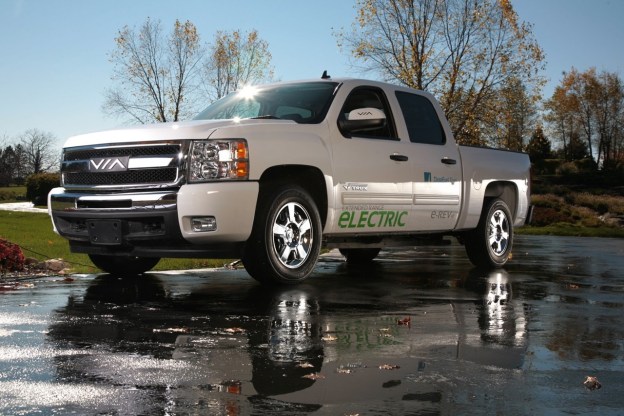 Green car startup VIA Motors will unveil three new plug-in hybrid vehicles at the Detroit Auto Show in January. VIA, which currently builds plug-ins based on Chevrolet trucks and vans, has the backing of former General Motors product czar Bob Lutz.
Green car startup VIA Motors will unveil three new plug-in hybrid vehicles at the Detroit Auto Show in January. VIA, which currently builds plug-ins based on Chevrolet trucks and vans, has the backing of former General Motors product czar Bob Lutz.
VIA’s plans look as ambitious as those of Fisker or Tesla. The company wants to build a luxury SUV, a 12-passenger van for airport shuttles and carpooling, and a high performance truck with up to 800 horsepower, dubbed X-Truck.
Details won’t be released until VIA’s Detroit press conference, but given the company’s existing lineup, it seems likely that the new plug-ins will be based on GM vehicles. VIA’s current offerings include the VTRUX, a Chevrolet Silverado with a plug-in powertrain, the VTRUX Suburban which, as the name implies, is a Chevy Suburban with the same powertrain, and the VTRUX Van, a plug-in Chevy Express.
With so much GM influence, it’s not surprising that VIA prefers the term “extended-range electric vehicle” to “plug-in hybrid.” Either way, VIA’s powertrain is similar to what one would find in a Chevy Volt or Fisker Karma.
A 4.3-liter V6 serves as a generator for the 24-kWh lithium-ion battery pack, which powers a 402 horsepower electric motor. As in the Karma, there is no physical connection between the gasoline engine and the wheels (the Volt can connect its engine to the wheels under certain circumstances).
Called VDrive, VIA says this powertrain can return 100 mpg in a typical 50-mile commute. Since the purpose-built 2013 Volt is rated at 98 MPGe by the EPA, that’s a pretty impressive claim for these full-size trucks. It’s likely the result of a long electric-only range; VIA says its trucks can travel up to 40 miles on battery power.
Pricing for the luxury and performance models will be announced in January, but VIA says a VTRUX pickup will cost $79,000. That’s almost twice as much as a loaded 2013 Silverado LTZ with a 6.2-liter V8 and four-wheel drive.
With its utilitarian attitude and off-the-shelf chassis, VIA is more of a Coda than a Fisker or Tesla. However, it has one thing that no green car startup has: the endorsement of an automotive celebrity.
Bob Lutz’s career has included stints at BMW, Ford, and Chrysler (where he pushed for development of the Viper) but he is known best for his work as Vice Chairman at GM. As the Detroit giant’s product czar, Lutz had his fingerprints on everything from the Pontiac Solstice and Saturn Sky sports car twins to the Volt.
Lutz joined VIA in September 2011, and unveiled the VTRUX line at the 2012 Detroit Auto Show.


